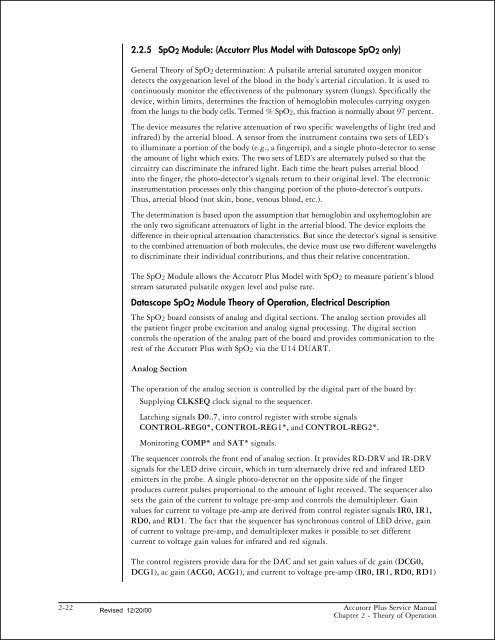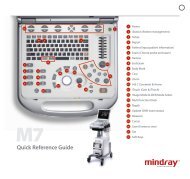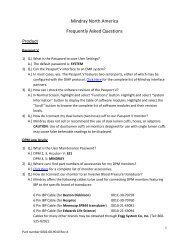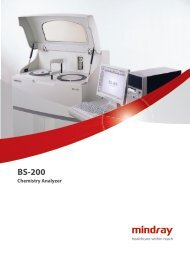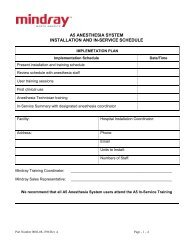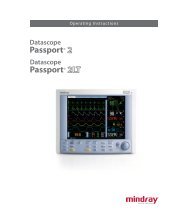Accutorr Plus Service Manual - Mindray
Accutorr Plus Service Manual - Mindray
Accutorr Plus Service Manual - Mindray
Create successful ePaper yourself
Turn your PDF publications into a flip-book with our unique Google optimized e-Paper software.
2.2.5 SpO2 Module: (<strong>Accutorr</strong> <strong>Plus</strong> Model with Datascope SpO2 only)<br />
General Theory of SpO2 determination: A pulsatile arterial saturated oxygen monitor<br />
detects the oxygenation level of the blood in the body’s arterial circulation. It is used to<br />
continuously monitor the effectiveness of the pulmonary system (lungs). Specifically the<br />
device, within limits, determines the fraction of hemoglobin molecules carrying oxygen<br />
from the lungs to the body cells. Termed % SpO2, this fraction is normally about 97 percent.<br />
The device measures the relative attenuation of two specific wavelengths of light (red and<br />
infrared) by the arterial blood. A sensor from the instrument contains two sets of LED’s<br />
to illuminate a portion of the body (e.g., a fingertip), and a single photo-detector to sense<br />
the amount of light which exits. The two sets of LED’s are alternately pulsed so that the<br />
circuitry can discriminate the infrared light. Each time the heart pulses arterial blood<br />
into the finger, the photo-detector’s signals return to their original level. The electronic<br />
instrumentation processes only this changing portion of the photo-detector’s outputs.<br />
Thus, arterial blood (not skin, bone, venous blood, etc.).<br />
The determination is based upon the assumption that hemoglobin and oxyhemoglobin are<br />
the only two significant attenuators of light in the arterial blood. The device exploits the<br />
difference in their optical attenuation characteristics. But since the detector’s signal is sensitive<br />
to the combined attenuation of both molecules, the device must use two different wavelengths<br />
to discriminate their individual contributions, and thus their relative concentration.<br />
The SpO2 Module allows the <strong>Accutorr</strong> <strong>Plus</strong> Model with SpO2 to measure patient’s blood<br />
stream saturated pulsatile oxygen level and pulse rate.<br />
Datascope SpO2 Module Theory of Operation, Electrical Description<br />
The SpO2 board consists of analog and digital sections. The analog section provides all<br />
the patient finger probe excitation and analog signal processing. The digital section<br />
controls the operation of the analog part of the board and provides communication to the<br />
rest of the <strong>Accutorr</strong> <strong>Plus</strong> with SpO2 via the U14 DUART.<br />
Analog Section<br />
The operation of the analog section is controlled by the digital part of the board by:<br />
Supplying CLKSEQ clock signal to the sequencer.<br />
Latching signals D0..7, into control register with strobe signals<br />
CONTROL-REG0*, CONTROL-REG1*, and CONTROL-REG2*.<br />
Monitoring COMP* and SAT* signals.<br />
The sequencer controls the front end of analog section. It provides RD-DRV and IR-DRV<br />
signals for the LED drive circuit, which in turn alternately drive red and infrared LED<br />
emitters in the probe. A single photo-detector on the opposite side of the finger<br />
produces current pulses proportional to the amount of light received. The sequencer also<br />
sets the gain of the current to voltage pre-amp and controls the demultiplexer. Gain<br />
values for current to voltage pre-amp are derived from control register signals IR0, IR1,<br />
RD0, and RD1. The fact that the sequencer has synchronous control of LED drive, gain<br />
of current to voltage pre-amp, and demultiplexer makes it possible to set different<br />
current to voltage gain values for infrared and red signals.<br />
The control registers provide data for the DAC and set gain values of dc gain (DCG0,<br />
DCG1), ac gain (ACG0, ACG1), and current to voltage pre-amp (IR0, IR1, RD0, RD1)<br />
2-22 Revised 12/20/00<br />
<strong>Accutorr</strong> <strong>Plus</strong> <strong>Service</strong> <strong>Manual</strong><br />
Chapter 2 - Theory of Operation


